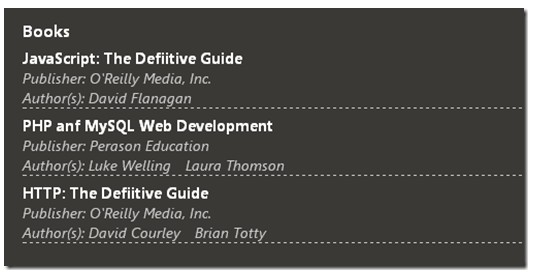jsonp原理及使用 |
|
初识jsonp 复制代码 代码如下: $.ajax({ type:get, url:http://test.com/books.php }); 页面会报一个这样的错误:XMLHttpRequest cannot load http://test.com/books.php. Origin http://localhost is not allowed by Access-Control-Allow-Origin.jsonp是为了解决这个问题出现的 。 jsonp原理 复制代码 代码如下: <script type="text/javascript" src="http://ajax.googleapis.com/ajax/libs/jquery/1.7.1/jquery.min.js"> </script> iframe、img、style、script等元素的src属性可以直接向不同域请求资源,jsonp正式利用script标签跨域请求资源的 简单实现 复制代码 代码如下: <?xml version="1.0"?> <books> <book name="JavaScript: The Defiitive Guide" publisher="OReilly Media, Inc."> <author>David Flanagan</author> </book> <book name="PHP anf MySQL Web Development" publisher="Perason Education"> <author>Luke Welling</author> <author>Laura Thomson</author> </book> <book name="HTTP: The Defiitive Guide" publisher="OReilly Media, Inc."> <author>David Courley</author> <author>Brian Totty</author> </book> </books> 明显JavaScript不能直接获取books.xml,在test.com中需要有一个机制将xml转化为json(这也就是为什么叫jsonp,其实和ajax一样,返回的数据不一定是json格式,只是json很好用),并动态拼接一条javascript调用语句返回,这个例子中直接使用php页面拼接 test.com/bookservice.php 复制代码 代码如下: <?php $path=$_SERVER["DOCUMENT_ROOT"]./books.xml; $json=json_encode(simplexml_load_file($path)); $callbackFn=$_GET[callback]; 这样首先把xml文件内容转换成一个json对象 复制代码 代码如下: {"book":[ {"@attributes":{"name":"JavaScript: The Defiitive Guide","publisher":"OReilly Media, Inc."},"author":"David Flanagan"}, {"@attributes":{"name":"PHP anf MySQL Web Development","publisher":"Perason Education"},"author":["Luke Welling","Laura Thomson"]}, {"@attributes":{"name":"HTTP: The Defiitive Guide","publisher":"OReilly Media, Inc."},"author":["David Courley","Brian Totty"]} ]} 然后拼接为一条javascript语句交给localhost去处理,当然test.com并不知道应该拼接的方法名叫什么,需要localhost在发送请求的时候在url中传入一个叫callback(这个也随便,两边同步就行)的参数指明 。看看localhost怎么发送请求吧 localhost/books.php 复制代码 代码如下: <!DOCTYPE html> <html> <head> <title>Books</title> <?php include(/components/headerinclude.php);?></head> <style type="text/css"> .book-title { font-size: 15px; font-weight:bold; margin-top:6px; } .book-info 我们希望在id为books的div中展示所有book,先添加一个用以显示book的javascript函数,也就是获取到数据后的回调函数,结合上面拼接的json格式可以这么写 复制代码 代码如下: function displayBooks(books){ var books=books.book; var booksContainer=document.getElementById(books); for(var i=0;i<books.length;i++){ var tmp=Array(); tmp.push(<div class="book-title">+books[i][@attributes].name+</div>); tmp.push(<div class="book-info">); tmp.push(<div>Publisher: +books[i][@attributes].publisher+</div>); tmp.push(<div>Author(s): ); if(typeof books[i].author==string){ tmp.push(books[i].author); }else{ var authors=books[i].author; for(var j=0;j<authors.length;j++){ tmp.push(authors[j]+ ); } } tmp.push(</div>); //end of author tmp.push(</div>); //end of book info booksContainer.innerHTML+=tmp.join(); } } 然后是关键的jsonp请求的方法了 复制代码 代码如下: function getBooks(){ var script=document.createElement(script); script.setAttribute(type,text/javascript); script.setAttribute(src,http://test.com/bookservice.php?callback=displayBooks); document.body.appendChild(script); } getBooks(); 在getbooks()方法中动态创建了一个script标签,设置其src为test.com提供的获取数据的service接口并传入回调函数,这样我们可以看看页面的反应,在Chrome控制台下可以看到这条请求  我们就可以在localhost下获取test.com的books了  jquery实现 在jquery中也有对jsonp的封装,不过jquery把其放到了ajax中,不明白为什么,毕竟这东西和ajax不太一样 。写一个jQuery版的 复制代码 代码如下: function getBooks(){ $.ajax({ type:get, url:http://test.com/bookservice.php, dataType:jsonp, jsonp:callback, jsonpCallback:displayBooks }); } 看起来完全一样,不过方便了很多,不用自己创建script标签神马的了,指明dataType为jsonp,回调函数不放在url内了,而是使用两个参数分别指明 。 安全性问题 |